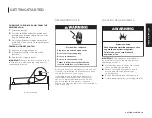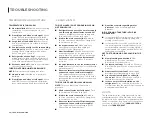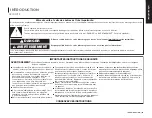
10 | GETTING STARTED
GETTING STARTED
REVERSE OSMOSIS WATER SUPPLY
IMPORTANT:
The pressure of the water supply
coming out of a reverse osmosis system going
to the water inlet valve of the refrigerator needs
to be between 30 psi and 120 psi (207 kPa and
827 kPa).
If a reverse osmosis water filtration system is
connected to your cold water supply, the water
pressure to the reverse osmosis system needs
to be a minimum of 40 psi (276 kPa).
If the water pressure to the reverse osmosis
system is less than 40 psi (276 kPa):
■
Check to see whether the sediment filter
in the reverse osmosis system is blocked.
Replace the filter if necessary.
■
Allow the storage tank on the reverse
osmosis system to refill after heavy usage.
■
If your refrigerator has a water filter, it may
further reduce the water pressure when
used in conjunction with a reverse osmosis
system. Remove the water filter. Refer
“Water Filtration System.”
If you have questions about your water
pressure, call a licensed, qualified plumber.
WATER SUPPLY REQUIREMENTS
Read all directions before you begin.
IMPORTANT:
■
When your refrigerator was installed,
the water connection from the water
source should have been connected to
your refrigerator. If your refrigerator is
not connected to a water source, refer
“Connect to Water Line” in the Installation
Instructions. If you have any questions
about your water connection, refer
“Troubleshooting” or call a licensed,
qualified plumber.
■
If you turn the refrigerator on before the
water line is connected, turn the ice maker
OFF. Refer “Ice Maker and Storage Bin.”
■
All installations must meet local plumbing
code requirements.
■
Connect to potable water supply only.
WATER PRESSURE
A cold water supply with water pressure
between 30 psi and 120 psi (207 kPa and 827
kPa) is required to operate the water dispenser
and ice maker. If you have questions about your
water pressure, refer “Troubleshooting” or call a
licensed, qualified plumber.
NOTE:
If the water pressure is less than what
is required, the flow of water from the water
dispenser could decrease or ice cubes could
be hollow or irregular shaped. If you have
questions about your water pressure, call a
licensed, qualified plumber.
Do not use with water that is microbiologically
unsafe or of unknown quality without adequate
disinfection before or after the system. Systems
certified for cyst reduction may be used on
disinfected waters that may contain filterable
cysts.
REMOVE THE PACKAGING
Remove tape and glue residue from surfaces
before turning on the refrigerator. Rub a small
amount of liquid dish soap over the adhesive
with your fingers. Wipe with warm water and
dry.
■
Do not use sharp instruments, rubbing
alcohol, flammable fluids, or abrasive
cleaners to remove tape or glue. These
products can damage the surface of your
refrigerator. For more information, refer
“Care and cleaning.”
■
Dispose of/recycle all packaging materials.
CLEAN BEFORE USING
After you remove all of the packaging materials,
clean the inside of your refrigerator before
using it. Refer the cleaning instructions in “Care
and cleaning .”
Important information to know about glass
shelves and covers:
Do not clean glass shelves or covers with warm
water when they are cold. Shelves and covers
may break if exposed to sudden temperature
changes or impact, such as bumping.
Tempered
glass is designed to shatter into many small,
pebble-sized pieces. This is normal. Glass
shelves and covers are heavy. Use both hands
when removing them to avoid dropping.
Содержание EDR3RXD1B
Страница 2: ......
Страница 47: ...47 NOTES ...











































